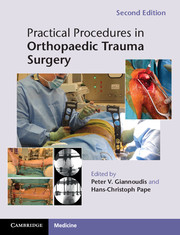Book contents
- Frontmatter
- Dedication
- Contents
- List of Contributors
- Preface
- Acknowledgements
- Part 1 Shoulder girdle
- Part 2 Upper extremity
- Part 3 Pelvis and acetabulum
- 8 Fractures of the pelvic ring
- 9 Section I: Fractures of the acetabulum
- Section II: Fractures of the femoral head
- Part 4 Lower extremity
- Part 5 Spine
- Part 6 Tendon injuries
- Part 7 Compartments
- Index
Section II: Fractures of the femoral head
Published online by Cambridge University Press: 05 February 2014
- Frontmatter
- Dedication
- Contents
- List of Contributors
- Preface
- Acknowledgements
- Part 1 Shoulder girdle
- Part 2 Upper extremity
- Part 3 Pelvis and acetabulum
- 8 Fractures of the pelvic ring
- 9 Section I: Fractures of the acetabulum
- Section II: Fractures of the femoral head
- Part 4 Lower extremity
- Part 5 Spine
- Part 6 Tendon injuries
- Part 7 Compartments
- Index
Summary
Indications
Large/displaced fractures of the femoral head. Typically occurs in conjunction with hip dislocation.
Operative treatment is offered in the majority of these fractures (those managed non-operatively are typically intrafoveal fractures – Pipkin 1, non-displaced fractures with congruent and stable joint without any interposed fragments).
Excision of the fragments is appropriate when they are small and their fixation is deemed questionable intraoperatively.
Those fractures classified as Pipkin IV (associated with acetabular fracture) are typically approached using the surgical approach during the ORIF of the acetabular fracture, as part of the same procedure (usually via a Kocher–Langenbeck posterior approach combined with a trochanteric osteotomy and surgical dislocation of the femoral head).
Clinical assessment
Usually a result of high-energy trauma, so thorough assessment of the patient according to ATLS principles should precede any focus given to the femoral head injury itself.
History related to the mechanism of injury, including the time that has elapsed since the accident.
Dislocation of the hip joint is usually present at initial assessment unless spontaneous reduction has occurred. Closed hip reduction is usually attempted, and is successful in about 80% of the cases.
Neurovascular assessment of the extremity should be performed and recorded before and after any intervention.
- Type
- Chapter
- Information
- Practical Procedures in Orthopaedic Trauma Surgery , pp. 239 - 245Publisher: Cambridge University PressPrint publication year: 2014

